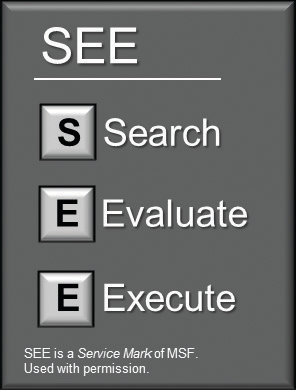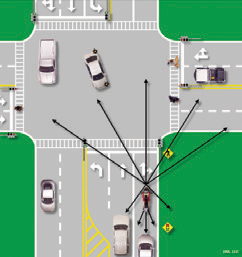
All Locations Closed for New Years Day 2026
All locations are closed Thurs 1 Jan, 2026 for the holiday.
Section 5: Street Strategies
Section 5: Street Strategies
This Section Covers
- Risk Awareness/Acceptance – 5.1
- Risk Management – 5.2
- Intersections – 5.3
- Space Management – 5.4
- Escape Routes – 5.5
- Increasing Conspicuity – 5.6
- Speed Management – 5.7
Safe riding is more of a skill of the eyes and mind than of the hands and feet. You need to develop a set of street riding strategies that allows you to gather critical information to make good decisions and avoid problems.
5.1 – Risk Awareness/Acceptance
Almost all activities people engage in have some level of risk. Operating a motorcycle requires your constant and full attention to reduce risk. Consider the following steps to manage risk and be a responsible rider:
Rider Responsibilities
Accept the responsibilities associated with operating a motorcycle:
- You must have a motorcycle license or permit.
- You will be expected to follow the laws and rules of the road.
- You must share the road with other users (i.e. pedestrians, bicyclists, large vehicles, etc.)
- Ride alcohol and drug-free.
- Always wear protective gear.
Risk Awareness
Riding a motorcycle involves some risks not encountered when driving other types of vehicles. Some of these risks include:
- Vulnerability – motorcycles provide less protection in a crash and do not have the stability of cars. This is why you should always wear protective gear.
- Visibility – motorcycles are not as visible as other types of vehicles because of their size. Other motorists may not be looking for motorcycles in traffic. This places you at risk.
Risk Acceptance
Once you become aware of the risks associated with motorcycling, it is time to accept those risks. Choosing to accept the challenges of being a responsible motorcyclist means to think about the consequences of your riding behavior in traffic. It also means accepting personal responsibility for the results of your decisions and actions, as well as developing good skills and judgment.

5.2 – Risk Management
To manage risk, you must be aware of the potential risks and then have a plan to reduce the risks.
SEE℠
SM – SEE is a Service Mark of MSF. Used with permission.
SEE is a powerful, but simple, strategy - Search, Evaluate, Execute. It is the strategy to help you understand what is going on in traffic and to be constantly planning and implementing a course of action. Let’s examine each of these steps.
Search

Searching aggressively as far ahead as possible, to the sides and behind to identify potential hazards and escape routes, may help to avoid a crash. When searching ahead, you should search for:
- Road and surface characteristics – potholes, bridge gratings, railroad tracks, debris, curves, slippery surfaces, etc. may influence your riding strategy.
- Traffic control markings and devices – look for traffic signals and signs to help you know what to expect ahead.
- Other roadway users – vehicles in front of you traveling in the same direction, those behind you, vehicles traveling in the opposite direction, those entering and leaving the roadway and turning. Pedestrians also can cross your path of travel or reduce your escape route options.
While it’s most important to keep track of what’s happening ahead, you can’t afford to ignore situations behind. Knowing what’s going on behind will help you make a safe decision about how to handle trouble ahead. To search behind:
- Check your mirrors – frequent mirror checks should be part of your normal searching routine. Make a special point of using your mirrors when you are stopped at an intersection, before you change lanes, and before you slow down.
- Use head checks – checking your mirrors is not enough. Motorcycles have “blind spots” like cars. Before you change lanes, turn your head, and look to the side for other vehicles. Only by knowing what is happening all around you, are you fully prepared to deal with it.
Don’t forget to check the instruments and gauges regularly, too.